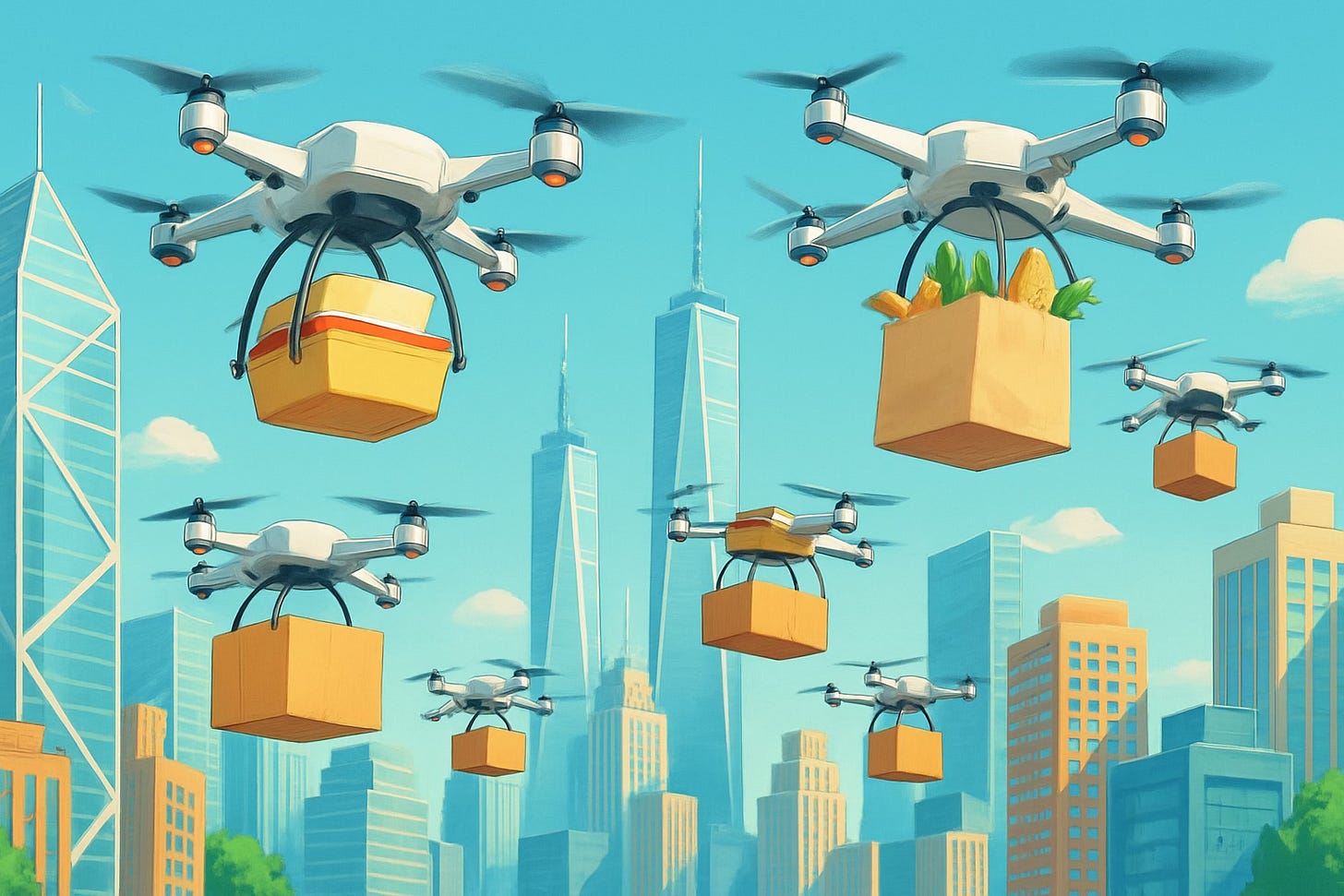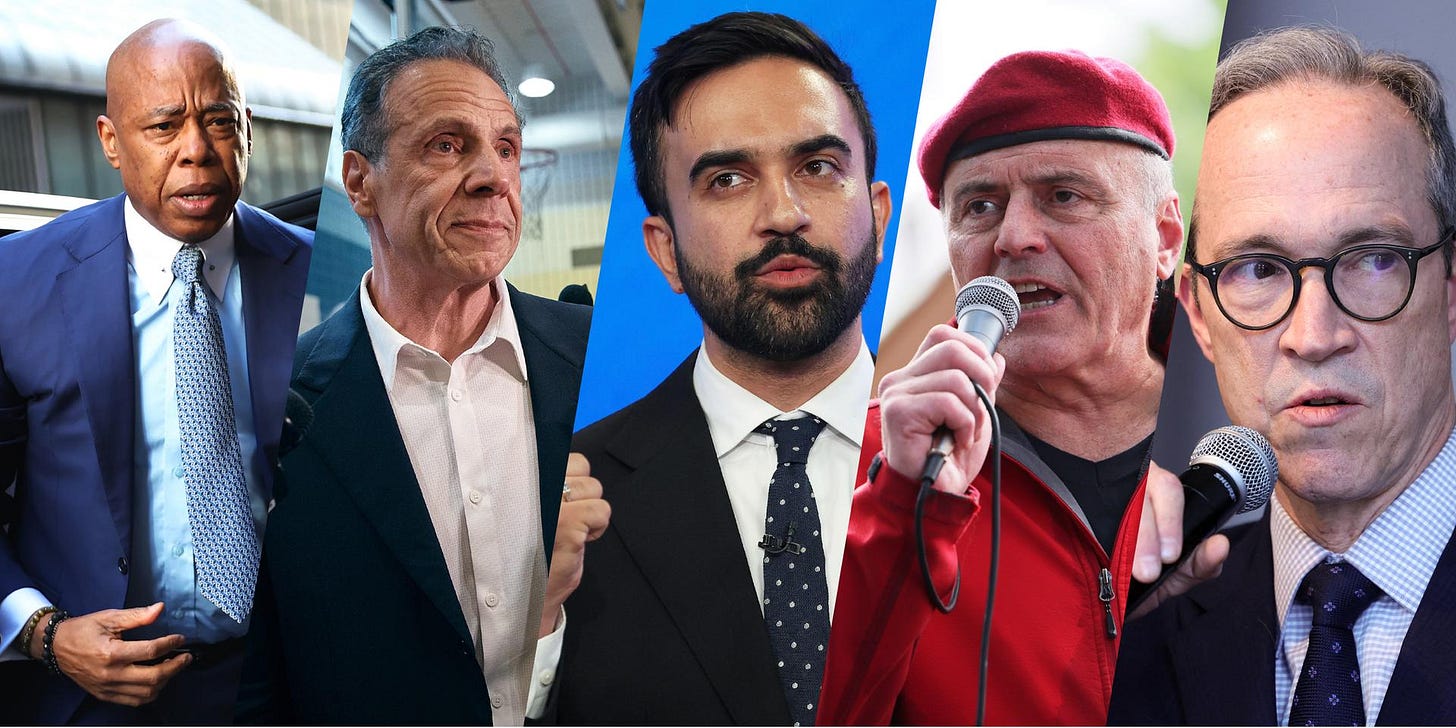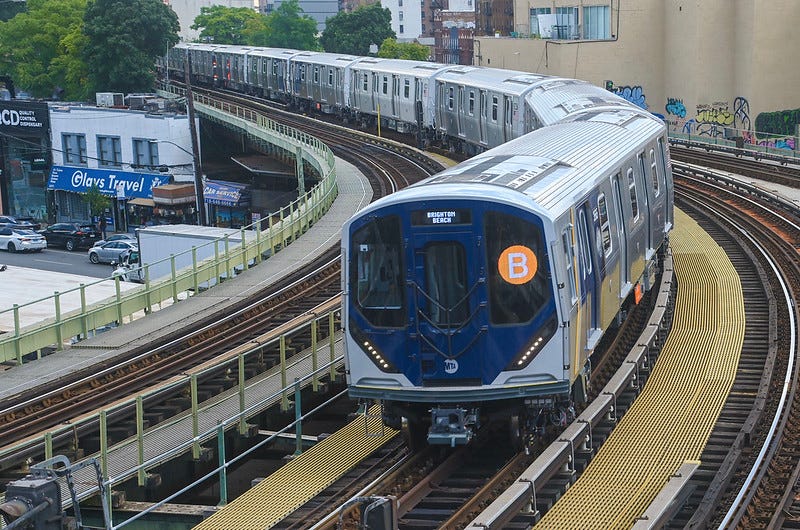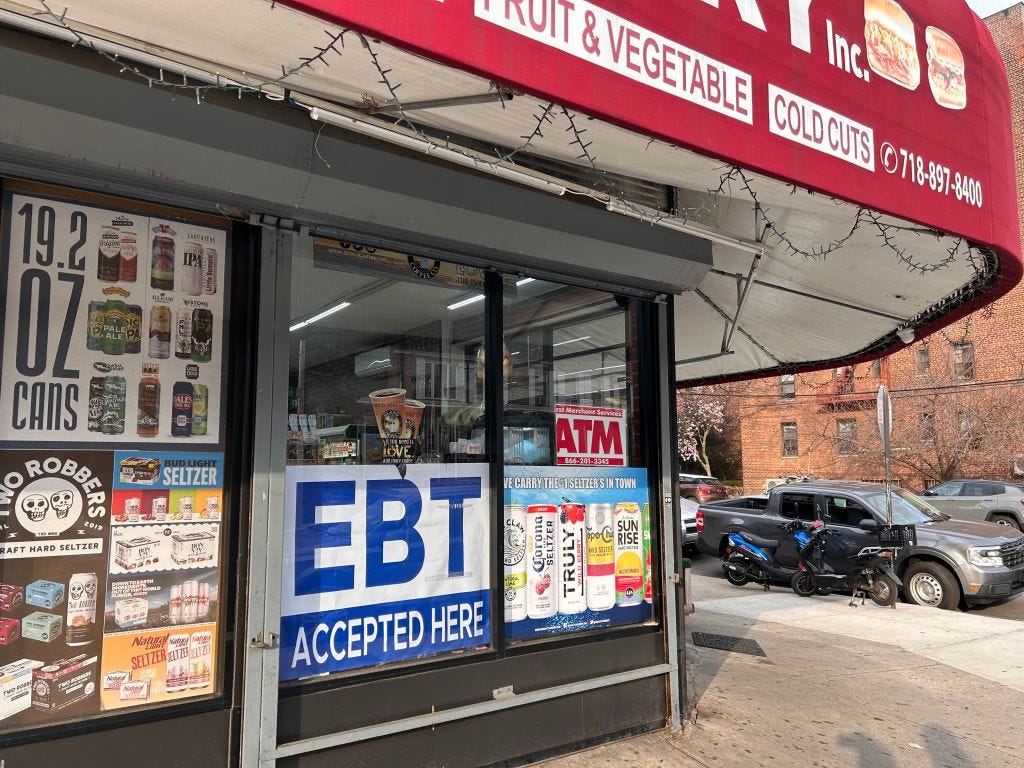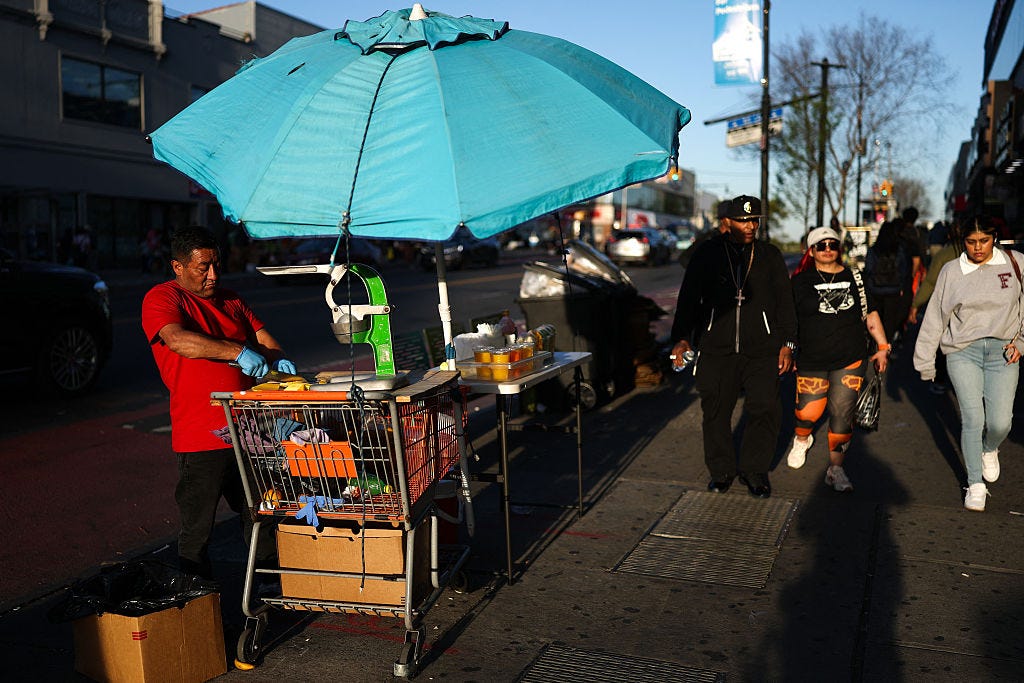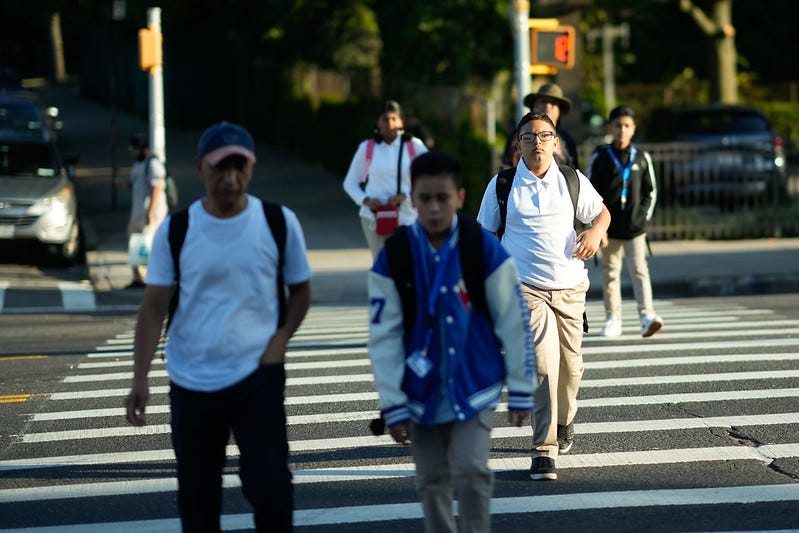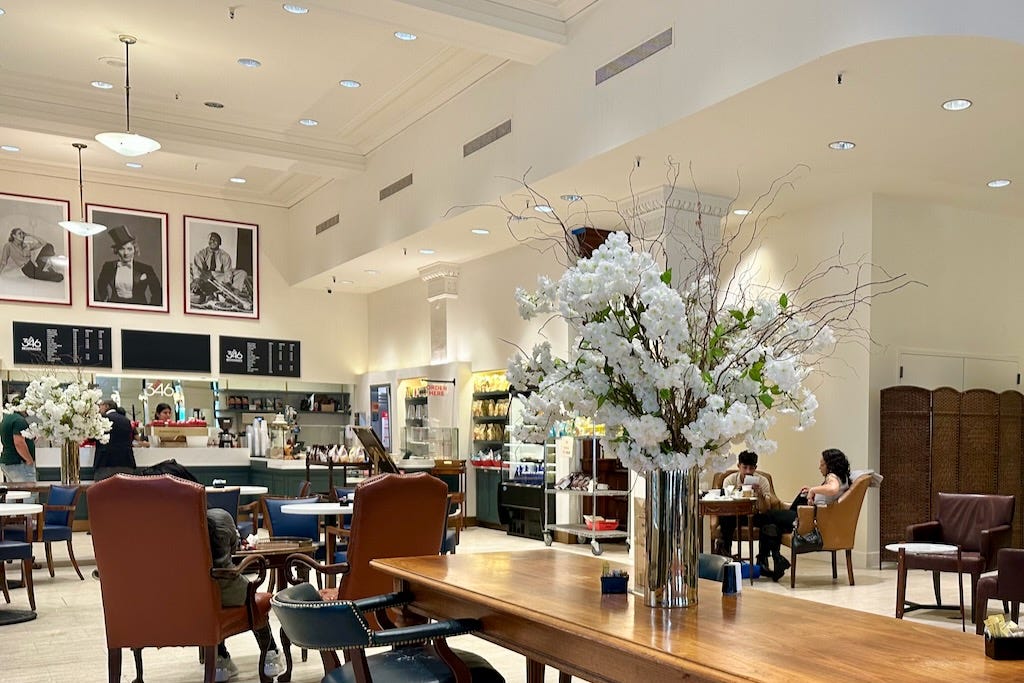The Race to Deliver
The real challenge for city government is to proactively guide and manage technological innovations that change urban life—rather than waiting to respond after the fact.
This week, New York closed the "Instacart loophole," establishing that delivery workers are to earn a guaranteed $21.44 an hour, regardless of whether they deliver takeout or groceries. Companies warn of higher prices and business costs, but for now, it's a win for the workers.
Yet just as the city shores up protections, a new challenge is emerging: the rise of drones and automation in urban delivery. In Texas, North Carolina, and California, platforms like DoorDash have launched drone delivery pilots, offering faster service in often congested or spread-out areas. Though workers still manage packing and logistics, the trend indicates a move toward greater automation.
New York has often been slow to adapt to new technologies. As Nicole Gelinas pointed out last week, the real challenge for city government is to proactively guide and manage technological innovations that change urban life—rather than waiting to respond after the fact. If officials don’t take a more active role, our skies could end up just as congested and chaotic as our streets.
In global cities such as Shenzhen, drones have already become part of daily life, speeding up urban logistics. New York is right to raise standards for its workforce, but it must also prepare for what's already on the horizon.
Mamdani’s To Lose?
Zohran Mamdani now leads the New York City mayoral race with 46% support, well ahead of Andrew Cuomo (24%), Curtis Sliwa (15%), and Eric Adams (9%), according to the latest Siena/NYT poll. His advantage rests on a coalition anchored by voters under 50 and renters. But in a one-on-one matchup, his lead over Cuomo narrows sharply to 48–44, underscoring the risk if the field consolidates.
Despite growing pressure—including behind-the-scenes job offers and even overtures linked to Trump—both Adams and Sliwa have refused to exit. The infighting has turned personal, with Adams calling Cuomo “a snake and a liar.” For now, the split opposition preserves Mamdani’s edge, but his ability to hold it will depend on keeping his coalition energized while rivals continue dividing the anti-Mamdani vote.
Subways, Safety, and Who Should Respond
At a recent Vital City forum, Mamdani argued again that New York leans too heavily on the police to manage public safety. Armed officers, he said, deal with everything from fare evasion to mental-health crises, leaving fewer resources for fighting violent crime. He called for a new Department of Community Safety to handle non-criminal emergencies and for scaling up mental health outreach teams, especially on the subway.
While major felonies on the subway overall are back to or below 2019 levels, according to the Governor, assaults are still substantially higher than pre-pandemic, and a spring 2025 MTA survey found just 57% of frequent riders feel safe in the system. So Governor Kathy Hochul will continue her high-visibility strategy, mandating two officers on every overnight train. She and MTA leaders point to record-low overall transit crime in August—22% below a year earlier—as proof that the surge works, even if it costs tens of millions.
Curtis Sliwa, who has patrolled the trains since the 1970s with his Guardian Angels, maintains that the solution to subway safety remains the same: increasing transit police patrols on trains, something he'd bring back if he were to be elected mayor in November.
But there may be a less costly fix—reassigning conductors to walk trains to observe conditions and summon NYPD only when needed, an idea Gelinas wrote about a few months back. The Transit Workers Union Local 100 has resisted switching to one-person train operation, a move that would save the MTA significant funds and bring New York in line with the transit systems in other cities, such as London, Paris, Tokyo, Chicago, and Washington, D.C.
Risky Business: SNAP Cuts Will Squeeze City's Grocers
At Frank Pimentel’s Superfresh in the South Bronx, roughly 40% of sales are paid for with federal SNAP benefits. That revenue keeps more than 60 workers employed and sustains a store built with city FRESH program incentives to expand food access in a neighborhood once labeled a food desert. Cuts to SNAP under Donald Trump’s “One Big Beautiful Bill” would squeeze households and retailers alike.
“Our margins are really, really thin, and I will have to take action to make my business sustainable,” Pimentel told The City.
Independent grocers average profit margins are just 1.4%, according to the National Grocers Association. With so little cushion, owners say job cuts and reduced hours are inevitable. Nationally, SNAP supports an estimated 388,000 jobs; in some stores, it accounts for as much as 70% of sales.
Street Vending: Politics Over Policy
The City Council this week overrode another of Mayor Adams’ vetoes, passing Intro 47-B to decriminalize street vending. Sponsored by Council Member Shekar Krishnan, the bill converts criminal penalties for unlicensed vendors into civil fines and sharply reduces maximum penalties for repeat offenses.
Adams warned that the change undermines quality-of-life enforcement. Council leaders countered that the bill was shaped with input from Adams’ own Street Vendor Advisory Board and reflects a view that vendors should be treated as small businesses, not criminals.
“Today was a decisive victory for immigrants in NYC,” Krishnan declared, presenting the bill as a shield against Trump-era crackdowns and the threat of detention at 26 Federal Plaza.
On paper, the bill aligns vending with other minor business infractions. In practice, it risks replicating the city’s struggle with reckless e-bike riders: penalties exist, but without credible enforcement, rules are meaningless.
Street vending has long been a gateway to entrepreneurship for immigrants, and that is unlikely to change anytime soon. Adams is right to worry about order; Krishnan is right to question criminalization. What the city hasn’t done is bridge those poles with a transparent, enforceable, and fair system.
An Education Agenda for New York City’s Next Mayor
New York City spends more per student than any other city, yet too many children still fall behind.
New York City’s public schools are losing students but spending more: enrollment has dropped by nearly 70,000 since 2020, even with tens of thousands of new immigrant arrivals, while the budget has climbed to $40 billion—pushing per-pupil costs to more than $32,000, the highest in the nation, writes Danyela Souza Egorov, arguing that New York's schools are nations most inefficient. Academic results remain weak, with over 40% of students in grades 3–8 not proficient in reading or math and chronic absenteeism at 35%. Families are increasingly opting out: homeschooling has risen 68% since 2020, and the Black student population has fallen by more than half over two decades.
In a new Manhattan Institute report, Egorov and Ray Domanico argue this is the result of political choices, not inevitabilities. They point to the Bloomberg years, when closing failing schools and demanding results delivered progress, as proof that disciplined reform works, and propose restoring school performance report cards, enforcing consequences for persistently failing schools, reducing chronic absenteeism, and keeping mayoral control of the system.
The takeaway: only transparency, choice, and high standards will make New York’s public schools a reason for families to stay, not leave.
Meeting Place
Cafe 346 is a spacious, bright cafe at 346 Madison Avenue at the corner of East 44th street, offering coffee, pastries, and brunch options in what was once a Brooks Brother’s flagship location. But hurry, because there are plans to redevelop this location as 44+Madison, a 41-story office skyscraper.


